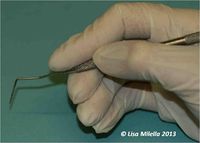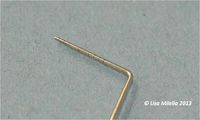Difference between revisions of "Periodontal Probe"
Jump to navigation
Jump to search
Ggaitskell (talk | contribs) |
|||
| Line 11: | Line 11: | ||
*Evaluate extent of [[Dental Indices and Criteria#Tooth Mobility|tooth mobility]] | *Evaluate extent of [[Dental Indices and Criteria#Tooth Mobility|tooth mobility]] | ||
| − | The markings are either engraved rings or colour coded bands. A screening probe for example has 3 or 4mm banded block markings whilst a Williams periodontal probe is more accurate with mm markings. Before using the probe, the operator should ensure that they know what the | + | The markings on the probe are either engraved rings or colour coded bands. A screening probe for example has 3 or 4mm banded block markings whilst a Williams periodontal probe is more accurate with mm markings. Before using the probe, the operator should ensure that they know what the markings represent by comparing the probe to a ruler. |
[[Category:Dental Instruments]] | [[Category:Dental Instruments]] | ||
| − | [[Category:To Do - | + | [[Category:To Do - Mars Check]] |
Revision as of 22:08, 17 September 2013
The periodontal probe is a narrow rounded or flat, blunt-ended, graduated instrument. Due to its blunt end, it can be inserted into the gingival sulcus without causing trauma.
The periodontal probe is used to:
- Measure periodontal probing depth
- Determine degree of gingival inflammation by gentle probing
- Measure gingival attachment loss (recession)
- Evaluate furcation lesions
- Evaluate extent of tooth mobility
The markings on the probe are either engraved rings or colour coded bands. A screening probe for example has 3 or 4mm banded block markings whilst a Williams periodontal probe is more accurate with mm markings. Before using the probe, the operator should ensure that they know what the markings represent by comparing the probe to a ruler.

